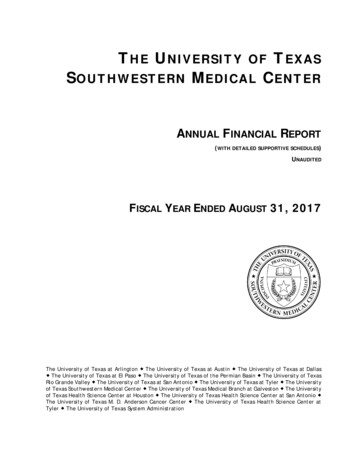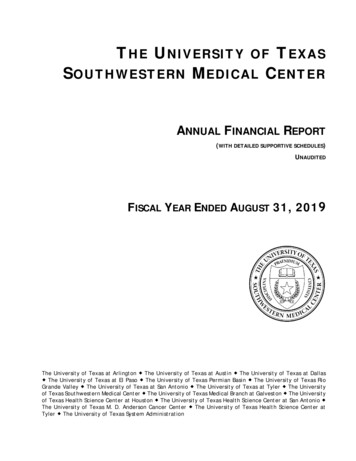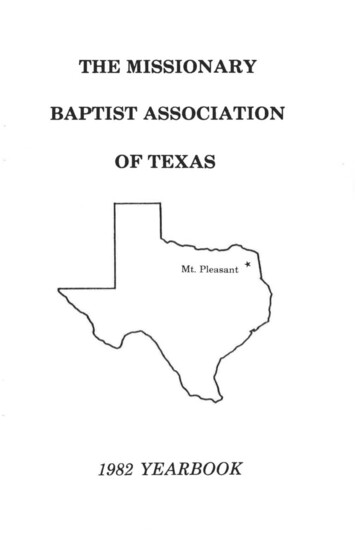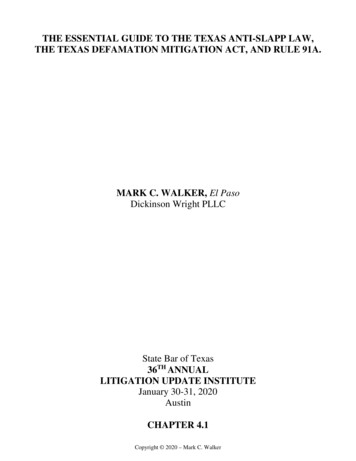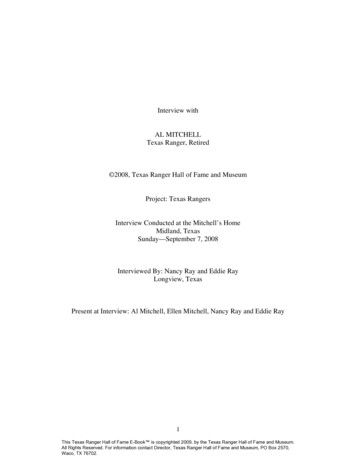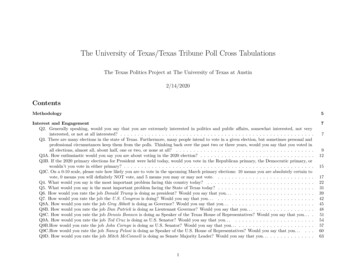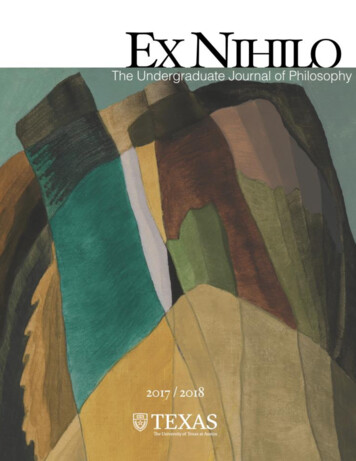
Transcription
EX NIHILOThe Undergraduate Journal of Philosophy2017–2018
EX NIHILO 2017-2018This project would have been impossible without the supportof the philosophy department at UT Austin, and specialthanks are in order for our advisor Susan Somers, andProfessor Al Martinich.3
EX NIHILO 2017-2018EDITORIAL STAFFCole Dulworth and Grecia ReynaEditors-in-ChiefMax AndersonReaderAzam BaigReaderShiri SpitzReaderJohn-David StackReaderJohn-Calvin PierceCopy EditorJacket Design by Cole DulworthAdapted from:Arthur Dove (American, b. 1880, d. 1946), "Shore Road", 1942. WaxEmulsion on Canvas, 70.8 x 50.8 cm.4
EX NIHILO 2017-20185
EX NIHILO 2017-2018TABLE OF CONTENTSSEX IS ABOUT POWER:Dissecting Pornography’s Role in the Sexual Language Game8Hitaxhe KupaThe University of Pennsylvania“POINT-AND-PROCLAIM”:A Possible Response to the Grounding Problem15Eli BarrishThe University of Texas at AustinCHOOSING EUDAEMONIC EMOTIONS:Aristotle and the Proto-Stoic Theory of Emotions22Abdulwausay I. AnsariThe University of HoustonAFFIRMING NEO-ARISTOTELIAN TELEOLOGYAnd its Applications in Normative Medical Ethics30Nathan WongThe University of Texas at Austin6
EX NIHILO 2017-20187
EX NIHILO 2017-2018SEX IS ABOUT POWER:Dissecting Pornography’s Role in the Sexual Language GameHitaxhe KupaThe University of PennsylvaniaINTRODUCTIONIn this paper, I offer a pragmatic and philosophical critique of Rae Langton andCaroline West’s Scorekeeping in a Pornographic Language Game. I begin the paper bydeveloping Langton and West’s argument that pornography is a speech act that can beunderstood as partly continuous with other speech, yet different to the ways of politicalargument. Pornography, they argue, subordinates and silences women. I offer apragmatic critique in identifying the divergence of the pornographic language game andthe [general] sexual language game. Then, I offer a philosophical critique thatundermines pornography’s status as an exercitive speech act. Langton and West, whilesufficiently ascribing pornography to continuous speech, failed to contest MacKinnon’sselective definition of pornography and failed to appeal to the power-based analysis ofgender that attributes authority to pornographers.IDEVELOPMENT OF PORNOGRAPHY AS A SPEECH ACTLangton and West begin in presenting two strongly contrasting views ofpornography and its status as a speech act, both of which bear heavily on an importantpolitical question: is a ban on pornography (or at least violent pornography) justifiable?The first view is that of Ronald Dworkin: the rational argument. According to Dworkin,pornography is political speech that aims to persuade its listeners of the truth of certainideas about women. When pornography delivers the “message” that women aresubmissive, or enjoy being dominated, it is likened to speech advocating that womenoccupy inferior roles. This form of speech, as defined by Dworkin, is protected underthe First Amendment. The second view is that of Catharine MacKinnon: the reductiveargument. According to MacKinnon, pornographic speech is the result of psychological8
EX NIHILO 2017-2018conditioning that associates violence and misogynistic views with sexual stimuli. In thisview, pornography is not political speech, but a non-rational stimulus; thus, a ban onviolent pornography can be supported. Langton and West claim both views areextremes and not wholly plausible; they propose a moderate thought that qualifiespornography as speech that produces effects on beliefs, desires, and behavior.Langton and West are exploring two important feminist claims: pornographysubordinates and silences women. They proceed on the assumption that pornography isspeech. Referencing MacKinnon, they argue that pornography as speech has a certaincontent and acts in a certain way. Said by an authoritative speaker, the speech has anillocutionary doing that legitimizes attitudes and behaviors. In the case of pornography,pornography signifies women are inferior and sexual violence is normal and legitimate.The purpose of this paper is to broadly support MacKinnon’s claims:pornography is not protected by the First Amendment. First, there is the question ofwhat pornography says: Does pornography really say that women are inferior, or thatsexual violence is normal and legitimate? Langton and West find two reasons of doubt:(1) pornography does not say these things explicitly and (2) pornography purports tobe fiction. Langton and West dispel the first doubt in referencing David Lewis’sScorekeeping in a Language Game: there is a distinction between explicit speech andpresupposed, implied, and suggested speech. Lewis discusses the rule-governedlanguage game. In a speech situation, “saying” is more than an utterance of strings ofwords, it is to make a move in the language game. The components of the score are settheoretic constructs, such as sets of presuppositions. The score of the game is basedoff the acceptability value of the sentences. It is important to note that scorekeepingevolves over time, what is taboo in one generation, is acceptable in another.Langton and West narrow in on the Rule of Accommodation: speech requirescomponents of conversational score to be a certain way. Illocutionary moves arepermissions and prohibitions that may be explicit or implicit. To illustrate the rule, theyrefer to a master’s prohibition that a slave crosses a white line. The master couldexplicitly prohibit the slave, or say something that presupposed the slave was not allowedto cross the white line. The master could say, “I hereby prohibit you to cross this whiteline.” which is an explicit move of prohibition to cross the line. The master could alsosay, “The punishment for leaving the grounds is death.” which is an implicit move ofprohibition to cross the line. Pornography’s claims that women are inferior or thatsexual violence is normal can be presupposed, rather than explicitly stated. For example,9
EX NIHILO 2017-2018a favorable gang rape depiction presupposes “gang rape is enjoyable for men.” Theyconclude pornography can say such things even if it does not explicitly say them.Second, there is the question of whether pornography speaks with authority. Theconclusion about pornography’s power to subordinate and silence women requires thepremise about pornography’s authority. To answer the question of subordination,Langton and West once more refer to the slave and the master. The master’s ability tosubordinate the slave, using words, depends on his authority. The master’s words havepower because he is the master. Pornography, they argue, has the authority to legitimizesexual violence and thus subordinate women. To answer the question of silence, the rulesof accommodation prevent certain intended moves in a language game. Women arecomparatively powerless in sexual language games; women cannot, or do not, challengepornography’s score in the language game.Finally, pornography purports to be fiction. According to Langton and West,fictional stories are played out on a background of fact. Pornographers are liars, orbackground liars that make fictional propositions [about what women enjoy], orbackground blurrers – they fail to indicate the line between fiction and background.Langton and West conclude that pornography changes the conversational score in life,making it continuous enough with other speech.IICONFLATION OF PORNOGRAPHIC LANGUAGE WITH SEXUALLANGUAGEIn this section I want to raise the question: How much of a role doespornography have to play in the sexual language game? To begin, I want to highlightCatharine MacKinnon’s definition of pornography: ‘the graphic sexually explicitsubordination of women in pictures or words that also includes women dehumanizedas sexual objects, things or commodities; enjoying pain or humiliation or rape; beingtied up, cut up, mutilated, bruised, or physically hurt; in postures of sexual submissionor servility or display; reduced to body parts, penetrated by objects or animals, orpresented in scenarios of degradation, injury, torture; shown as filthy or inferior;bleeding, bruised or hurt in a context which makes these conditions sexual.’ Accordingto MacKinnon, pornography does not just cause harm to women, pornography is harmto women.As by MacKinnon’s definition, pornography is the graphic sexually explicitsubordination of women, whether in pictures or in words. The mark of thepornographic for MacKinnon is that it celebrates, eroticizes or legitimates the sexual10
EX NIHILO 2017-2018subordination of women. On this view, pornography does not just depict the sexualsubordination of women: it endorses the sexual subordination of women and bylegitimating women’s subordination, pornography subordinates. MacKinnon wants toargue that pornography conditions its consumers to be sexually aroused by thedegradation, humiliation, brutalization, and objectification of women.This definition obviously excludes material that would otherwise count aspornographic, such as gay pornography. I want to argue that MacKinnon’s definition(as it is also appropriated by Langton and West) is disparate with social and legaldefinitions of pornography. As such, it hinders the effective advocacy of equalizing thesexual language game. Socially, pornography refers to material dealing with sex designedto arouse its readers or viewers. Legally, there are two types of pornography that receiveno First Amendment protection — obscenity and child pornography. The social andlegal definitions operate in tandem.The legality of pornography has been traditionally determined by implementingthe Miller Test. The test dictates that the opinion of the local community on apornographic piece is most important in determining its legality. The basic guideline forobscenity is as follows: (a) whether 'the average person, applying contemporarycommunity standards' would find that the work, taken as a whole, appeals to theprurient interest. . . (b) whether the work depicts or describes, in a patently offensiveway, sexual conduct specifically defined by the applicable state law; and (c) whether thework, taken as a whole, lacks serious literary, artistic, political, or scientific value."Legality is of concern in assessing MacKinnon, and later Langton and West, as theyover-archingly call for the censorship of pornography that subordinates women.There is an important component to the social definition of pornography: “sexuallyexplicit.” There are multiple mediums that subordinate and silence women that are outsidethe social and legal definition of pornography. I briefly cover four such mediums.1. AdvertisementIn November, 2015, Bloomingdales, the upscale department store, published anew holiday catalog. A woman is laughing, head tossed back, focused on somethingover her right shoulder. A man stares at her, unsmiling. The caption reads: Spike yourbest friend’s eggnog when they’re not looking. The ad sends the message that it is ok to havesex with people who are incapable of consent. In April, 2015, Bud Light published anew label: “The perfect beer for removing ‘no’ from your vocabulary for the night.”Both Bloomingdales and Bud Light faced accusations of promoting rape.11
EX NIHILO 2017-20182. MusicIn Robin Thicke’s hit single “Blurred Lines,” he sings “I know you want it”eighteen times. In the song “U.O.E.N.O,” Rick Ross raps, “Put Molly all in herchampagne, she ain’t even know it; I took her home and I enjoyed that, she ain’t evenknow it;” Both popular songs have pro-date rape messages, removing the sense ofagency in women.3. Video GamesThe video game “RapeLay” is a rape stimulator. The agent in the gamemethodically rapes his way through a family of three women. The game features a seriesof screens informing the player of how they can stalk the women. The virtual womenscream and cry; the player is able to force them into a variety of positions. The gamefeatures disturbing graphics like blood upon raping the young virgin girls, and the abilityto invite your friends to assist in a gang rape.4. NovelsAs of June, 2015, Fifty Shades of Grey, the best-selling book, had sold over 125million copies world-wide. The book features sexual practices involving bondage,dominance/submission, and sadism/masochism (BDSM). The problem is that FiftyShades casually associates hot sex with violence, but without any of the consent.Sometimes, Ana, the main character, says yes to sex she’s uncomfortable with becauseshe’s too shy to speak her mind, or because she’s afraid of losing Christian, her businessmagnate boyfriend; she gives consent when he wants to inflict pain, yet that doesn’tprevent her from being harmed.There is strong cultural evidence of the language game that provides men withrules of accommodation and silences women. However, the conflation of thepornographic language game with the inherently unequal sexual language game producesuntenable differences in the social and legal definition of pornography andMacKinnon’s definition of pornography. While the hard-core pornography that mutilateswomen may be considered obscene and thus censored, what of the soft-core pornographyor implicit messages on the subconscious that perpetuate the subordination of womenand normalization of sexual violence across multiple mediums? MacKinnon’s definitionis deliberate. She wants to ban pornography on the grounds it reduces women tosecond-class citizens. Pornography, as the speech act that Langton and West argue, is12
EX NIHILO 2017-2018an act of gender discrimination and hence illegal. They write, “Whatever the reason,pornography affects the pre-suppositional score in the sexual language game.” Thepornographic language game is not equivalent to the sexual language game, it is merelyone component. There exists media that adheres to MacKinnon’s definition ofpornography, but not the social and legal definitions of pornography. As a result, wehave a philosophical stalemate concerning the status of speech and its potentialsubjection to censorship.IIIPORNOGRAPHY IS NOT A STANDARD EXERCITIVETo briefly critique pornography’s status as speech that subordinates andsilences women, I will refer to a paper by Mary McGowan, On Pragmatics, Exercitive SpeechActs and Pornography. First, standard exercitives express the content of the permissibilityof facts enacted. For example, if a parent tells a child, “no television until yourhomework is complete,” they express the content of the permissibility. Langton andWest do not sufficiently describe how pornography enacts permissibility facts withoutexpressing the content of those facts. Second, excercitives express both theillocutionary and the locutionary speaker intentions. The producers, distributors, andpurveyors of pornography do not intend to be enacting permissibility conditions of anykind. Langton and West would agree: “pornography is designed to generate, notconclusions, but orgasms.” Such illocutionary intention would generate political speech,as Dworkin suggests. The speaker’s intention is an important part of how exercitivespeech acts work. Even if the speech acts do not constitute a necessary condition ofexercitive force, the conditions are important evidence that a particular speech act hassuch force – or that pornography has the authority to subordinate and silence women.Third, the hearers, or those exposed to pornography, cannot recognizeintentions that are non-existent. Recognition of intentions is an important epistemiccriterion of standard exercitive force. Forth, the authority to enact permissibility ofpornographers is questionable. Langton and West did not appeal to structural or powerbased analysis of gender, nor the power of media, nor the power of mass-distributionof large corporations. Langton and West failed to establish and provide evidence forthe authority of pornographers. They do not want to concede that pornography acts ona level of unconsciousness through the form of psychological conditioning;pornography would not be a speech act if that were the case. However, Langton andWest failed to account for pornography’s function at the conscious level ofcommunicated intentions. This objection undermines the speech act approach to13
EX NIHILO 2017-2018pornography. Referring to the ideas in Section II, Langton and West’s conception ofpornography fails to enact permissibility facts by triggering the rules operative in asystem of gender oppression.CONCLUSIONIn this paper, I developed Langton and West’s theory of pornography as a speechact. I offered a pragmatic rejection against the conflation of the pornographic languagegame and sexual language game that is inherently gender-unequal. I offered aphilosophical rejection that undermines pornography’s status as an exercitive speechact. Oscar Wilde is known to have said, “Everything in the world is about sex, exceptsex. Sex is about power.” If we account for the power-based analysis of gender, we canunderstand a more robust intersection of speech and feminism.14
EX NIHILO 2017-2018“POINT-AND-PROCLAIM”:A Possible Response to the Grounding ProblemEli BarrishThe University of Texas at AustinABSTRACTThe two-thinger holds that distinct objects can be spatiotemporally coincident,but when two things are colocated, one must wonder how they can share someproperties without sharing all. If objects match in primitive properties, what groundstheir so-called “higher order” differences? I consider why someone might want to be atwo-thinger, despite this problem. I then evaluate the primitivist solution proposed byKaren Bennett, and explore an alternative that she rejects: the “point-and-proclaim”model. Bennett’s primary objection to point-and-proclaim is that it requires a namer toname one among a “bazillion” indistinguishable objects. In response, I develop a newmodel for the naming of indistinguishables. Rather than pointing to an object, thenamer merely tags the first unnamed object that rises to the surface of an infinite wellof indistinguishable objects. “Point-and-proclaim” is shown to be a misnomer, one thatmight draw undue disparagement for a potentially appealing response to the groundingproblem.ITHE GROUNDING PROBLEMThe two-thinger holds that distinct objects can be spatiotemporally coincident.When a lump of clay, Lumpl, is shaped into a statue, Goliath, the two things will seemto share all properties, including spacetime location. But what is in a name? ThoughGoliath and Lumpl match primitively and look exactly the same, significant differencesemerge. Lumpl, as a lump of clay, survives being kicked across the room, whereasGoliath, the statue, is destroyed. Goliath, however, will do better than Lumpl at an artauction. In virtue of what do Lumpl and Goliath diverge in these “higher order”15
EX NIHILO 2017-2018properties? This paper considers why someone might want to be a two-thinger, despitethis grounding problem. It then evaluates the primitivist solution provided by KarenBennett, and explores an alternative she quickly rejects: the “point-and-proclaim”model. To help with this task, I develop a new model for the naming ofindistinguishable objects.The two-thinger’s position is best justified by explanation of the difficultiesfacing the one-thinger. According to Leibniz’s law, objects with different properties aredistinct. So if a region of spacetime contains coincident objects exhibiting differentproperties, then plural distinct objects live there, vindicating the two-thinger. To remaina one-thinger, one must either deny Leibniz’s law (some do so readily--but I will notenter that fray), deny that Lumpl and Goliath differ in properties, or deny that they arecolocated. Lumpl and Goliath occupy the exact same spatiotemporal location; Lumpl,after all, is the stuff of which Goliath is made. Lumpl and Goliath certainly seem toexhibit different properties. At least two groups of properties seem to differ betweenLumpl and Goliath:1. Goliath could survive a chipped nose, while Lumpl could not. The two objectshave different persistence conditions.2. Goliath is a statue, while Lumpl is not. Lumpl is a piece of clay, while Goliath isnot. These categorical differences register as different sortal properties.Taken together, these sortalish properties (Bennett’s language) create problems forthe one-thinger. Despite being colocated and similar in many primitive ways, if onekeeps faith with Leibniz, Lumpl and Goliath are distinct. There are certainly pathsforward for the one-thinger (including denial of Leibniz’s law), but the strongestdefense is a fierce offense. The two-thinger also faces a tremendous problem, says thatone-thinger, a problem that makes Lumpl and Goliath more trouble than they areworth. Bennett puts the grounding problem like this:“[I]n light of the fact that spatio-temporally coincident things have all oftheir other properties in common, in virtue of what do they have thesortalish properties they do?”.16
EX NIHILO 2017-2018In other words, if Lumpl and Goliath look the same, occupy the same slice inspacetime, smell the same, feel texturally the same, etc., then why do they live and dieby different principles—why do they sell for different prices—why are they, simply,different kinds of things? Bennet proposes three ways for the two-thinger to respond tothe grounding problem: first by maintaining that things have sortalish properties invirtue of their non-sortalish ones; second by delegating responsibility for propertiesonto our concepts and attitudes; third by claiming that sortalish properties, are, in fact,primitive, thus evading the brunt of the grounding problem . The first response(supervenience of non-sortals) I leave to Bennett to handle; the second (conceptualism)I explore with the point-and-proclaim model; and the third (primitivism) I will nowcritically evaluate.IIPRIMITIVISMPrimitivism holds that all the sortalish properties held essentially by an object arealso held primitively. For instance, one might suppose that Goliath has the properties“essentially a statue,” “essentially man-shaped,” and “essentially made of clay.” For theprimitivist, these essential, sortalish properties are primitive. They are had by Goliath invirtue of nothing else. By claiming such sortalish properties as primitive, Bennett avoidsthe difficulty of explaining what grounds them. However, Bennett must still respond toa problem of distribution. Goliath essentially has the sortalish property of “survives achipped nose,” but lacks the property “survives being smashed against the ground.”Why? Not how, but why? This question does not rehash the grounding problem; it asksfor explanation of why certain primitive sortals go with various objects.Bennett employs a theory of plenitude. She says that the multi-thinger, whenfaced with the grounding problem, should claim that for any spacetime regioncontaining an object, all possible sortal properties are instantiated. There exists, nearGoliath, a thing that isn’t exactly Goliath, but instead a Goliath-like thing that survivesbeing smashed. It isn’t Goliath because has this extra property. We use naming to groupout certain sortals. The thing we term “Goliath” has essentially the primitive propertyof failing to survive smashing, but nothing grounds this property.According to Bennett, this position ought to be palatable to the multi-thingerbecause: (A) the multi-thinger already defends two colocated objects; why not abazillion? and (B) there exists no appealing alternative. But bazillion-thingerdom hashidden costs. For one, it requires extreme ontological commitment. Now every regionof spacetime, insofar as it is occupied by anything, is occupied by everything. Goliath17
EX NIHILO 2017-2018and Lumpl are joined by all the infinite near-Goliath and near-Lumpl neighbors,expressing properties like “survives being sawed in half,” “would not make the cut atSotheby’s,” “looks better from a certain angle,” and so on. There is no end to thesortalish properties one could think up for this region of spacetime. This ontologicalcommitment probably doesn’t trouble the two-thinger overmuch, but it is still worthconsidering.Among a bazillion things, one can still describe Goliath and list some of its sortalproperties. But one wonders what Bennett’s bazillion-thinger model adds. It addsvagueness--who knows what object among this muddle of similar objects the name“Goliath” should pick out? And although bazillion-thingerdom doesn’t imply that thenamer instantiates Goliath’s properties through the power of speech, it bearsresemblance. The namer must pick Goliath’s properties out of an infinite list. Theadvantage of the plenitude theoryis that it deems properties as already being present,whereas under the point-and-proclaim theory properties owe their existence to thenamer’s instantiation.Primitivism also produces weak generalizable principles for grounding sortalishproperties. Let us switch from Goliath to the statue that represents the Western idealof male beauty: Michelangelo’s David. For Bennett, the property of David being“essentially handsome” has no grounding principle; it is primitive. The property ofDavid being handsome could very well be grounded in David’s facial symmetry, hislithe and youthful form, or his attire. But isn’t it easier to say David is handsome invirtue of being essentially handsome? Bazillion-thingerdom opens this unfortunatedoor to grounding non-essential sortals in essential sortals every time. Say that one alsofinds Goliath to be a handsome statue. One would like to find points of comparisonbetween Goliath and David; both are strapping young men with bulging muscles. Butprimitivism would ground David’s handsomeness in his essential handsomeness, not intraits he might share with Goliath. One could ground Goliath’s handsomeness in hisphysique, but just as easily one could claim that Goliath has essentially the property ofbeing handsome, and that this property grounds his more mundane features (includingmuscles). This illustrates an almost Euthyphroean dilemma for the bazillion-thinger: isGoliath handsome because of his shape and attributes, or is he shaped that way becausehe is essentially handsome?Given plenitude, there is no clear answer to this question. This deficit, whichothers have also noticed, makes primitivism uniquely unappealing. What use are sortalproperties if they have nothing in common over their instantiation in several distinct18
EX NIHILO 2017-2018objects? In a sense, they no longer sort. Goliath is handsome. David is handsome. Butboth might be handsome primitively, or in virtue of entirely different primitives.Handsomeness, grounded in nothing else, gets particularized to each statue. Nothingnecessarily ties David and Goliath together. No shared non-sortals ground their goodlooks. So they are not really of the same kind. As a consequence, we lose any explanatorypower for how we, as humans, categorize objects.I do not pretend that these arguments are conclusive, but I hope they disturb theprimitivist bazillion-thinger enough to encourage them to continue looking for otherresponses to the grounding problem. Now, I will explore a response Bennett dismissesas “just unacceptable”: point-and-proclaim.III“POINT-AND-PROCLAIM” AND THE NAMING OFINDISTINGUISHABLESPoint-and-proclaim falls under the umbrella of conceptualism, which holds that anobject’s sortal properties are grounded by “human attitudes, concepts, andconventions.” Some properties clearly come about this way. The property of “beinghandsome” (whether applied to statue or human) is one of them. Insofar ashandsomeness is grounded, what, other than human preference, could ground it?Bennett supplies the example of “being hip,” a property whose grounds are cultural.The shag carpet once covered every hip apartment’s floor; now hardwood and concreteare more appealing.To pose conceptualism as an answer to the grounding problem, one must makesimilar claims for all sortalish properties. But I don’t think this requirement isoutlandish. The very word “sortal” implies sorting, an action done more by humansthan by the universe. The property “Goliath survives a chipped nose” can be conceivedof as conceptual in this way: we name Goliath with a description in mind, selecting theclay-matter that makes up the statue in a way that aligns with preconceived concepts.An art historian, imagining Goliath as a statue of a man, may think, A man survives losinga nose; therefore, man-shaped statues survive the same treatment; and for the Goliath he pointsto, this is so. Meanwhile, the sculptor of Goliath may look at his chipped creation andthink, My statue is destroyed! The art historian and the sculptor refer to different objectsin naming Goliath, choosing different persistence conditions to apply to differentobjects sharing one name. Neither the art historian nor the sculptor is wrong in theirnaming or in their statements about persistence.19
EX NIHILO 2017-2018To an outside observer, the art historian and the scuptor appear to be pointingat the same spacetime region and speaking about distinct objects. According to thepoint-and-proclaim model, that is, in fact, what they are doing. The pointer-andproclaimer gestures to Goliath and says that it survives a chipped nose. Another personpoints to Lumpl (or another Goliath), an indistinguishable object occupying the samespatiotemporal location, and says that it doesn’t survive a chipped nose. Before theproclamation, we have two indistinct objects (all properties in common); after theproclamation, the objects have different properties. This is the sticking point forBennett: the coaxing of different properties out of indistinguishable objects.Bennett’s particular issue is that point-and-proclaim requires us to point to aparticular object, even when there is nothing distinguishing that object from itscolocated neighbors. When we proclaim Goliath to be handsome, we need to first findGoliath among all the indistinguishable Goliath-like statues occupying the samespacetime. In response, I would lik
to MacKinnon, pornography does not just cause harm to women, pornography is harm to women. As by MacKinnon's definition, pornography is the graphic sexually explicit subordination of women, whether in pictures or in words. The mark of the pornographic for MacKinnon is that it celebrates, eroticizes or legitimates the sexual


